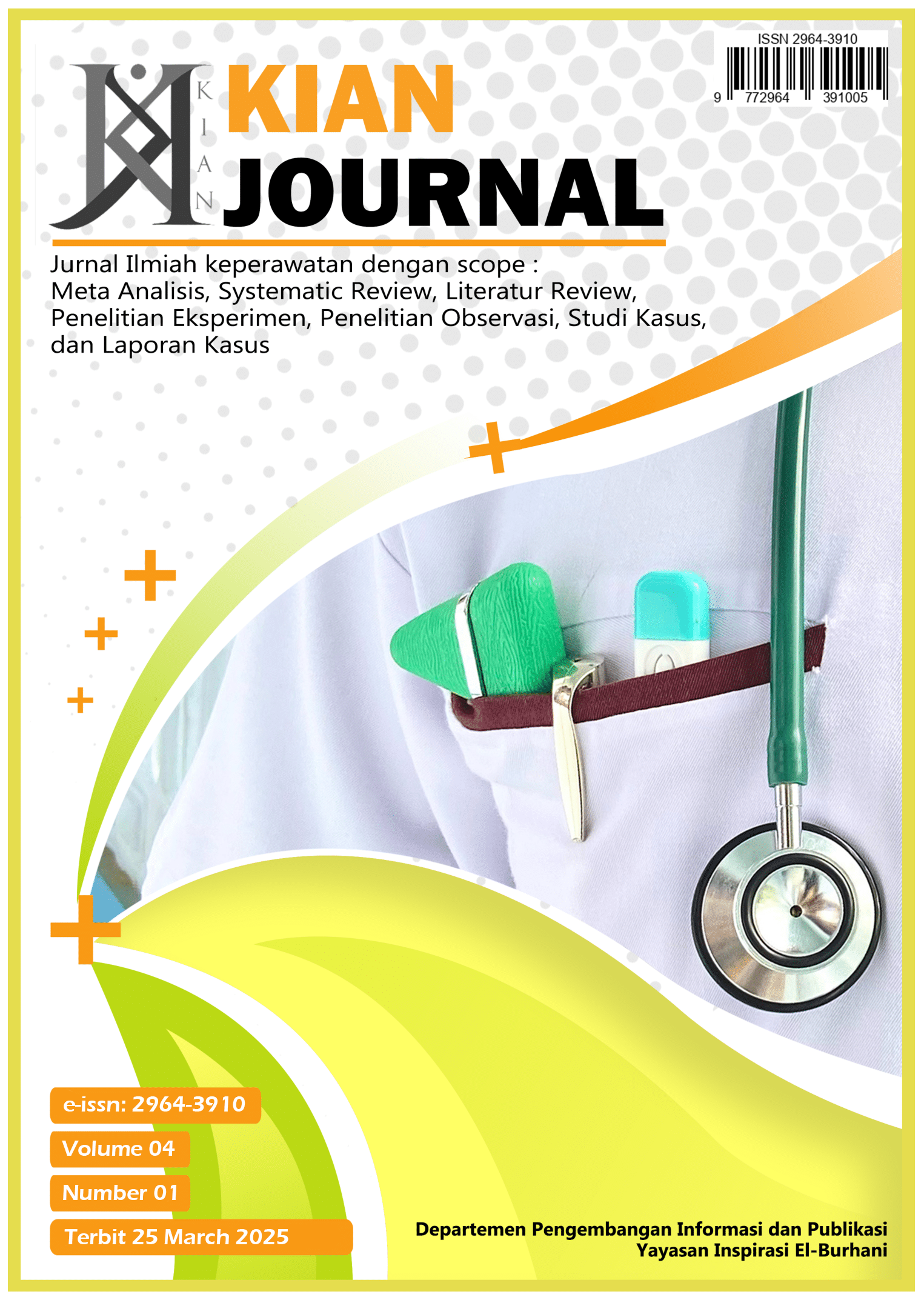The Effect of Speech Therapy on Aphasia Levels in Non-Hemorrhagic Stroke Patients in the Seruni Room of Rsud Hajjah Andi Depu
DOI:
https://doi.org/10.56359/kian.v4i1.529Keywords:
Non-hemorrhagic stroke, aphasia, speech therapyAbstract
Introduction: Non-hemorrhagic stroke is a brain disorder caused by the cessation or blockage of blood flow to the brain. Aphasia is a disorder in language function that arises from brain injury. Speech therapy is a rehabilitation process for people with communication disorders, so that they can interact more effectively. The use of the AIUEO method in therapy can help improve pronunciation, so that it is more easily understood by others by moving the tongue, lips, and facial muscles.
Objective: This study aims to determine the effect of speech therapy on the level of aphasia in patients who have non-hemorrhagic stroke in the Seruni Room of RSUD Hajjah Andi Depu.
Method: This research design is quantitative with a pre-experimental approach. The method used is one group pretest-posttest design.
Results: The results of statistical analysis using the Wilcoxon Signed Ranks Test with the help of SPSS showed a significant value (2-tailed) of 0.004. This means (p<0.05), so that the alternative hypothesis (Ha) is accepted and the null hypothesis (H0) is rejected. Thus, there is a positive effect of speech therapy on the level of aphasia in non-hemorrhagic stroke patients in the Seruni Room of RSUD Hajjah Andi Depu.
Conclusion: A 2024 study at Hajjah Andi Depu Hospital found that speech therapy significantly improved aphasia in non-hemorrhagic stroke patients. Patients' aphasia scores significantly improved after speech therapy (p < 0.05).
Downloads
References
Andriani, D., Nigusyanti, A. F., Nalaratih, A., Yuliawati, D., Afifah, F., Fauzanillah, F., ... & Firmansyah, A. (2022). Pengaruh Range of Motion (ROM) Terhadap Peningkatan Kekuatan Otot Pada Pasien Stroke. Indogenius, 1(1), 34-41.
Bella, C., Inayati, A., & Immawati, I. (2021). Application of Passive Range of Motion (Rom) to Overcome Nursing Problems of Physical Mobility Obstacles in Non-Hemorrhagic Stroke Patients in Metro City. Young Cendikia Journal, 1(2), 216-222. http://jurnal.akperdharmawacana.ac.id/index.php/JWC/article/view/203
Chrisanto, E. Y., Ernita, C., Erlianti, F., Umsani, U., & Putri, E. L. (2022). Health counseling on stroke. JOURNAL OF Public Health Concerns, 2(3), 131-134. https://doi.org/10.56922/phc.v2i3.203
Haiga, Y., Prima Putri Salman, I., & Wahyuni, S. (2022). Differences in Diagnosis of Ischemic Stroke and Hemorrhagic Stroke with Transcranial Doppler Results at Dr. M. Djamil Padang General Hospital. Scientific Journal, 1(5), 391-400. https://doi.org/10.56260/sciena.v1i5.72
I Gusti Nyoman Cahya Aditya, Gede Angga Pradipta, E. S. (2024). introduction to stroke disease through website-based interactive multimedia. 1.
Kartika, A. A., Suwanto, A. W., & Wiratmoko, H. (2022). Nursing Care for Post-Stroke Clients with Verbal Communication Disorders in the Jenangan Ponorogo Health Center Area. Journal of Management Nursing, 1(4), 111-115. https://doi.org/10.53801/jmn.v1i4.66
Nuraliyah, S., & Burmanajaya, B. (2019). Coping Mechanisms and Helplessness Response in Stroke Patients. Jurnal Riset Kesehatan Poltekkes Depkes Bandung, 11(1), 38-43.
Permatasari, N. (2020). Comparison of Non Hemorrhagic Stroke with Motor Impairment in Patients with Risk Factors of Diabetes Mellitus and Hypertension. Scientific Journal of Health Sandi Husada, 11(1), 298-304. https://doi.org/10.35816/jiskh.v11i1.273
Riyadina, W., Pradono, J., Kristanti, D., & Turana, Y. (2020). Stroke in Indonesia: Risk factors and predispositions in young adults. Journal of Cardiovascular Disease Research, 11(2), 178-183. https://doi.org/10.31838/jcdr.2020.11.02.30
Setiawan et al. (2021). Diagnosis and Management of Hemorrhagic Stroke. Jurnal Medika Utama, 02(01), 402-406.
Yunita Suryani. (2019). Speech of Post-Stroke Broca's Aphasia Patients. Journal of Indonesian Language, Literature, and Teaching, 2.
Downloads
Published
How to Cite
Issue
Section
License
Copyright (c) 2025 M Syikir, Irna Megawaty, Yetry, Triwulansari Dewi

This work is licensed under a Creative Commons Attribution 4.0 International License.














